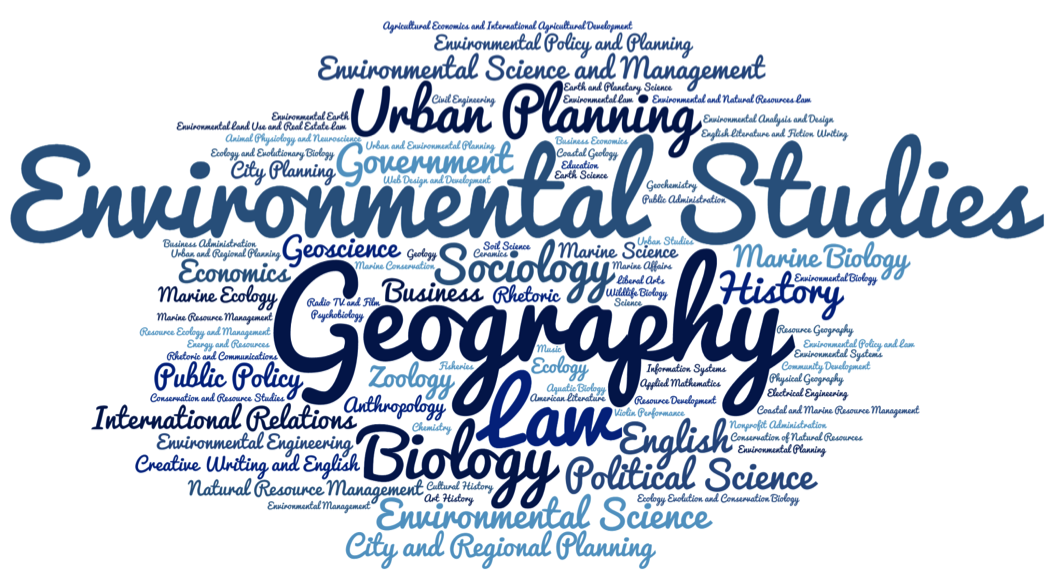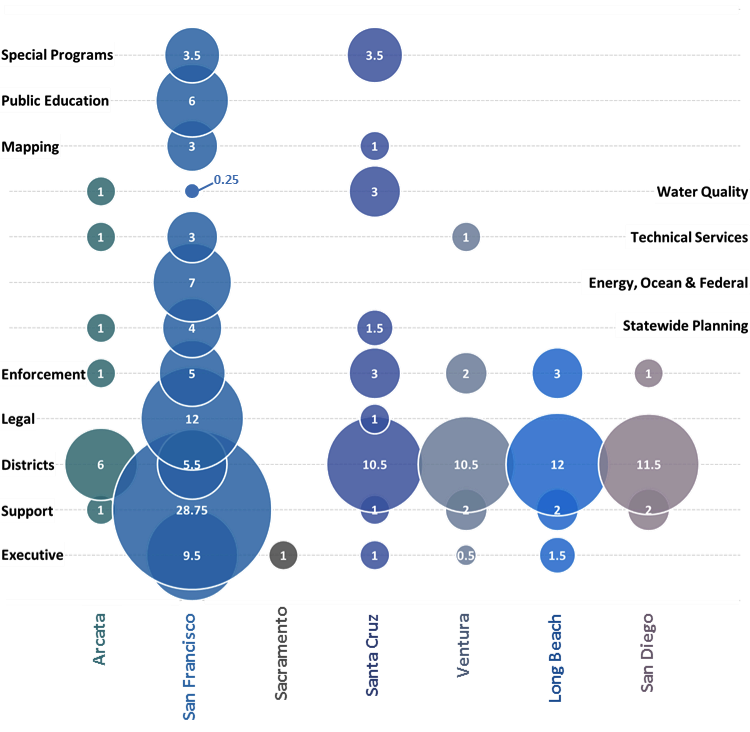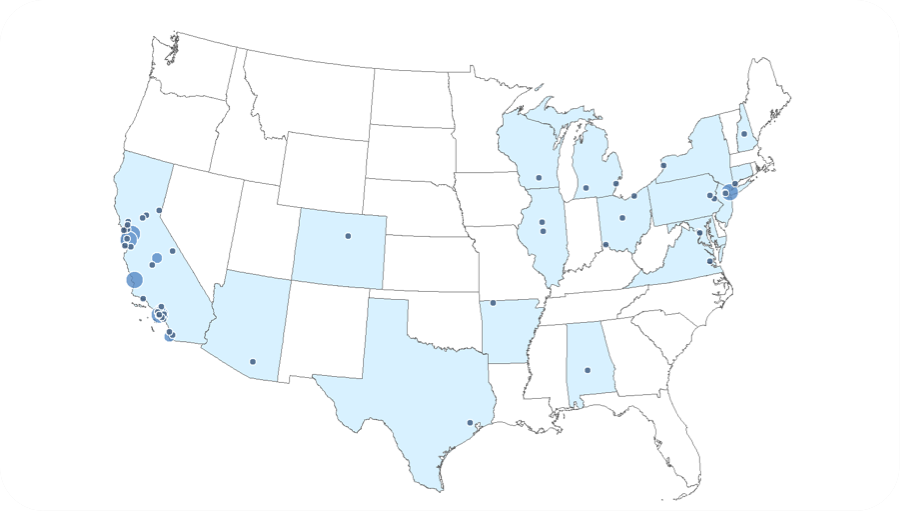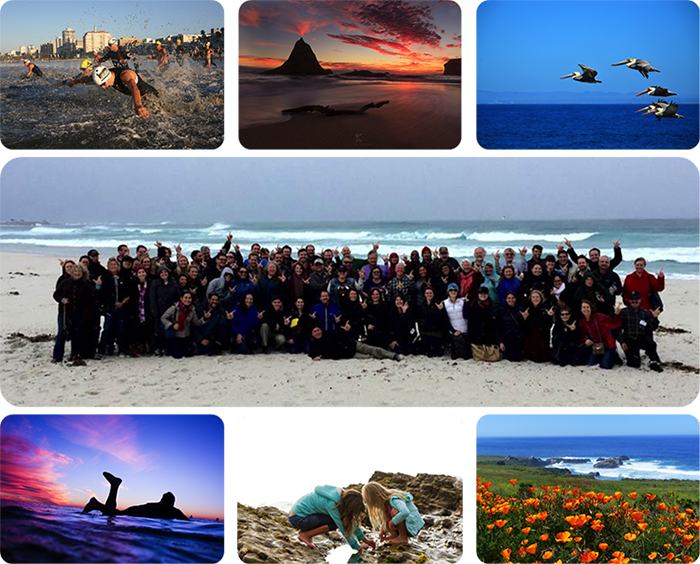My musing on the guardians of the Coastal Act began with information gathered by our public education team, which was originally intended to illustrate avenues for high schoolers. Via email, staff was asked for their majors/areas of study in undergraduate and graduate degrees. I’ve summarized the 95 responses received with the following graphic, offering a visualization of the educational backgrounds the agency draws from. Key subject areas included environmental studies & resource management, biological sciences, geography, law and policy, and planning.

Commission staff majors/areas of study. From undergraduate and graduate degrees, as originally provided in email responses. Image created using wordclouds.com.
I find it impressive that nearly 73% of the responding staff holds advanced degrees – 50 Masters, 12 JDs, and 7 PhDs[1]. Clearly, this is a place with a lot of smarts! The work demands it – as a regulatory agency, we are constantly challenged to think with a critical lens; as public servants, our approach is necessarily inclusive, cooperative, and sometimes creative in the pursuit of viable solutions. Along my own rather serpentine and perhaps arguably extended path, I have come to value professional versatility and academic range, and so I find it energizing to witness this among our tribe.
Given these educational backgrounds, I wondered about our composition as a team and distributions across the state. Using the internal staff directory (N=174), I extracted data for each staff member’s geographic post and unit. I combined a few of the units into larger groups[2] and tallied each by their office. In some cases, assignments were split among multiple offices or units – these are accounted for as fractions. The plot below illustrates how many people are associated with each office and unit.
[1] These numbers may be slightly off, as not all responses were explicit about what advanced degrees were earned. Therefore, it is possible that some of those reported as Master’s degrees may have been a double major during undergraduate studies, though this error should be relatively minor.
[2] Special Programs include staff working for the Access Program, Boating & Waterways, Caltrans Liaisons, and the Oil Spill Unit. Support staff includes people in Accounting, Business Services, Fiscal Services, Human Resources, Information Technology, Office Services, Publications, Records Management, and district office support staff such as Office and Information Technology Technicians.

Staff distributions. By office (columns) & unit (rows), number of staff (scaled bubbles, also labeled). Note that some staff split their time between different offices or units so fractions reflect this.
Half of the staff is based in San Francisco, an office which houses the North Central Coast District as well as Headquarters for everything from our core business and legal teams, to members of statewide planning, technical services, and public education. It also includes the core of the Climate Change Team that I work on, with most of us associating with the Statewide Planning and Executive units. The largest fraction of staff (40%) is dedicated to work at the level of the six districts. Also notable: women outnumber men considerably (63% and 37%, respectively).
When we conducted a three-day internal workshop on sea level rise in early December, a majority of the analytical, enforcement, legal, technical, and managerial staff attended along with a subset of the other units (N=110), I invited people to complete a brief survey. Approximately 50% of the attendees graciously humored me with their participation. As a California native with a strong sense of place (and stake in our coast!), I wondered where others originated from and asked. The map below illustrates Commission staff responses, with 80% claiming California as at least some part of their personal story and 45% including somewhere out-of-state. One individual even identified Israel as part of their origin (not displayed).

Commission staff origins. Blue bubbles (scaled to reflect the number of responses, range: 1-4; Ntotal=56) identify each of the localities staff members originally hailed from before landing in California’s coastal zone. Note that in some cases, more than one locality was reported. Image created by Mary Matella (2014 CCC Sea Grant Fellow).
I also wanted to know what people cherish about this strip of California we work to protect, so asked them to share their favorite thing, place, and/or activity related to the coast. Answers included places scattered across the 3427 miles of California’s coastline, from the Smith River mouth in Del Norte County to Sunset Cliffs in San Diego and out to the Channel Islands. Breathtakingly beautiful Big Sur was among the most frequently noted, but iconic beach communities like Venice and my home turf in Santa Cruz were also popular. Among the favorite activities reported were surfing & boogie boarding (29%), hiking (14%), and enjoying the beach with family (7%). Some people highlighted things like the sound of waves, the smell of the sea, various wildlife, and scenic vistas. To me, all of this highlights the resources Californians fought to protect in the 1970s with the passage of Proposition 20, establishment of the Coastal Commission, and adoption of the Coastal Act (i.e., access, recreation, marine and land resources). Today, we continue to benefit from this foresight and an incredible legislative effort that was designed to persevere in a changing world, protecting California’s coast for future generations. No doubt, Coastal Commission staff plays a critical role in upholding this legacy as well as interpreting the law mindfully as new challenges like offshore energy development and climate change emerge.
For an excellent historical account of the Coastal Act,
check out the Heroes of the Coast series and documentary.

Staff’s favorite places, activities & things about the coast. FIRST ROW: (LEFT) The race is on – Long Beach by Kevin Oules; (center) Golden Sunset – Martins Beach by Rupesh Dabbir; (RIGHT) Pelicans on Patrol – Pacific Grove by James J. Geiger; SECOND ROW: Coastal Commission Staff “Check the Coast” at the December 2015 Sea Level Rise Workshop – Asilomar Beach by CCC Staff; THIRD ROW: (LEFT) Surfer and the Sunset – Cardiff Reef by Amanda Scarski; (CENTER) Childhood Explorers – Montana de Oro by Kellie Neufeld; (RIGHT) Sea of Poppies – Pacific Valley, Big Sur by Mark Ray. All images in the first and third rows were submissions to the 2015 Annual California Ocean & Coastal Amateur Photography Contest.
Like many state agencies, the Coastal Commission is in an era of transition – as many career staff retire, a new generation of stewards is stepping up to carry on the mission. This is something that can be seen when walking the halls through the San Francisco office, and something which I have felt tremendous appreciation for. Tapping into the wealth of institutional knowledge via willing mentors is something that has accelerated my learning and deepened my understanding of our agency’s work in the past and present as well as for the future. When asked about their tenure at the agency, staff responding to my workshop survey provided a snapshot where combined, give a total >660 years of collective experience with an average of 11.8 years per individual... for only 56 of the 174 people currently working here! Note that the range extends from 43 years to only a few months (as I rounded up by year).

Agency Tenure. Beginning with the year when our most seasoned survey respondent indicated beginning their journey with the coastal commission, through today, the bars (left axis) indicate when staff members started working for the coastal commission (or in one case, the team leading up to its establishment). The shaded area indicates the years of experience contributed to a cumulative 662 years today (right axis).
Did I really say 43 years? Yes, I did. And I think that individual’s story embodies what this agency is about: she began gathering petitions in support of Proposition 20 (the precursor to the Coastal Act) as an undergraduate, then became an intern, then an analyst, and eventually succeeded to the highest ranks of the agency, while also becoming a mother and earning a graduate degree along the way. Talk about inspiring! Her commitment is simply awesome – it is truly an honor to work with someone whose knowledge and passion run so deep (you know who you are).
This brings me to my last survey question, which was about what motivates people to be a part of this agency. I admit that I expected a lot of variety in the answers, particularly as I wrote the survey in the days leading up to the workshop. But as I got to know more of our team through casual conversations and late night beers around the fire pit, I began to recognize that our shared values are exactly what drive this tribe. The thematic consistencies of survey responses reflect the sort of excellence and camaraderie at this agency that is inspired by its grass roots origins and fostered through steadfast leadership. Collectively, we serve the Coastal Commission because we believe in what we do. Half of the responses pointed to resource protection, which is what would naturally draw a person to an environmentally-protective agency. Almost equally consistent were an appreciation for the Coastal Act itself, a drive to make a difference, and reverence for colleagues.
The coast is never saved. It is always being saved.
Peter Douglas (1942-2012), former CCC Executive Director
The people serving the California Coastal Commission represent a mosaic of origins, educational backgrounds, generations, and preferences about how we spend our weekends, but we share a commitment to protecting the coast. I came to state government to serve something I believe in, to better my piece of the world, and to find a team that I could be proud to be a part of – and I’ve accomplished that. With the 40th anniversary of the Coastal Act fast approaching, and the torch of stewardship passing from one generation of coastal leaders to the next, I recognize that my colleagues will continue to passionately champion our mandate so that all who come to enjoy California’s coast will find inspiration. The Coastal Commission staff – past, present, and future – are my heroes and I thank them all for the work they do every day to steward this very special place.

Staff mosaic. The Coastal Commission icon composed of staff directory photos. Image created using easymoza.com.
Written by Lauren E. Garske, PhD



